Mason–Dixon line
This article needs additional citations for verification. (January 2017) |
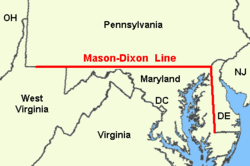
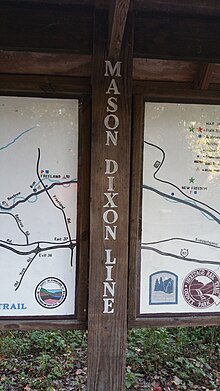
The Mason–Dixon line, also called the Mason and Dixon line or Mason's and Dixon's line, was surveyed between 1763 and 1767 by Charles Mason and Jeremiah Dixon in the resolution of a border dispute involving Maryland, Pennsylvania, and Delaware in Colonial America. It is still a demarcation line among four U.S. states, forming part of the borders of Pennsylvania, Maryland, Delaware, and West Virginia (originally part of Virginia before 1863). Later it became known as the border between the Northern United States and the Southern United States. Before the Missouri Compromise, the line (west of Delaware) marked the northern limit of slavery in the United States.
Background
Maryland's charter of 1632 granted the Calverts land north of the entire length of the Potomac River up to the 40th parallel. A problem arose when Charles II granted a charter for Pennsylvania in 1681. The grant defined Pennsylvania's southern border as identical to Maryland's northern border, but described it differently, as Charles relied on an inaccurate map. The terms of the grant clearly indicate that Charles II and William Penn believed the 40th parallel would intersect the Twelve-Mile Circle around New Castle, Delaware, when in fact it falls north of the original boundaries of the City of Philadelphia, the site of which Penn had already selected for his colony's capital city. Negotiations ensued after the problem was discovered in 1681. A compromise proposed by Charles II in 1682, which might have resolved the issue, was undermined by Penn receiving the additional grant of the "Three Lower Counties" along Delaware Bay, which later became the Delaware Colony, a satellite of Pennsylvania. Maryland considered these lands part of its original grant.[1]
The conflict became more of an issue when settlement extended into the interior of the colonies. In 1732 the proprietary governor of Maryland, Charles Calvert, 5th Baron Baltimore, signed a provisional agreement with William Penn's sons, which drew a line somewhere in between and renounced the Calvert claim to Delaware. But later, Lord Baltimore claimed that the document he had signed did not contain the terms he had agreed to, and refused to put the agreement into effect. Beginning in the mid-1730s, violence erupted between settlers claiming various loyalties to Maryland and Pennsylvania. The border conflict would be known as Cresap's War.
Progress was made after a Court of Chancery ruling affirming the 1732 agreement, but the issue remained unresolved until Frederick Calvert, 6th Baron Baltimore ceased contesting the claims on the Maryland side and accepted the earlier agreements. Maryland's border with Delaware was to be based on the Transpeninsular Line and the Twelve-Mile Circle around New Castle. The Pennsylvania–Maryland border was defined as the line of latitude 15 miles (24 km) south of the southernmost house in Philadelphia (on what is today South Street). As part of the settlement, the Penns and Calverts commissioned the English team of Charles Mason and Jeremiah Dixon to survey the newly established boundaries between the Province of Pennsylvania, the Province of Maryland, and Delaware Colony.[1]
In 1779, Pennsylvania and Virginia agreed "To extend Mason's and Dixon's line, due west, five degrees of longitude, to be computed from the river Delaware, for the southern boundary of Pennsylvania, and that a meridian, drawn from the western extremity thereof to the northern limit of the said state, be the western boundary of Pennsylvania for ever."[2]
After Pennsylvania abolished slavery in 1781, the western part of this line and the Ohio River became a border between slave and free states, with Delaware[3] retaining slavery until the Thirteenth Amendment was ratified in 1865.
Geography of the line

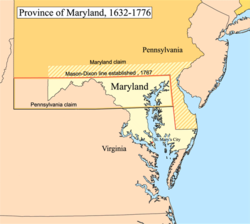
Mason's and Dixon's actual survey line began to the south of Philadelphia, Pennsylvania, and extended from a benchmark east to the Delaware River and west to what was then the boundary with western Virginia.
The surveyors also fixed the boundary between Delaware and Pennsylvania and the approximately north-south portion of the boundary between Delaware and Maryland. Most of the Delaware–Pennsylvania boundary is an arc, and the Delaware–Maryland boundary does not run truly north-south because it was intended to bisect the Delmarva Peninsula rather than follow a meridian.[4]
The Maryland–Pennsylvania boundary is an east–west line with an approximate mean latitude of 39°43′20″ N (Datum WGS 84). In reality, the east–west Mason–Dixon line is not a true line in the geometric sense, but is instead a series of many adjoining line segments, following a path between latitude 39°43′15″ N and 39°43′23″ N.
The surveyors also extended the boundary line 40 miles (64 km) west of Maryland's western boundary, into territory that was still in dispute between Pennsylvania and Virginia, though this was contrary to their original charter.[1] Mason and Dixon's survey was finished on October 9, 1767, about 31 miles (50 km) east of what is now Pennsylvania's southwest corner.[5]
In 1774, commissioners from Pennsylvania and Virginia met to negotiate their boundary, which at the time involved Pennsylvania's southern border west of Maryland and its entire western border. Both sides agreed that Pennsylvania's grant made its western border a tracing of the course of the Delaware River, displaced five degrees to the west. And both sides thought this would place Fort Pitt in Virginia territory (in fact it would not have). With that in mind, the governor of Pennsylvania argued that, despite the agreement reached with Maryland, Pennsylvania's southern border west of Maryland was still the 39th parallel, about 50 miles (80 km) south of the Mason–Dixon line. Negotiations continued for five years, with a series of proposed lines. In the end, a compromise was reached: the Mason–Dixon line would be extended west to a point five degrees west of the Delaware River. To compensate Pennsylvania for the claimed territory lost, its western boundary would be run due north rather than copying the course of the Delaware River.[1]
The Mason–Dixon line was marked by stones every mile and "crownstones" every 5 miles (8.0 km), using stone shipped from England. The Maryland side says "(M)" and the Delaware and Pennsylvania sides say "(P)". Crownstones include the two coats of arms. Today, while a number of the original stones are missing or buried, many are still visible, resting on public land and protected by iron cages.[6]
Mason and Dixon confirmed earlier survey work, which delineated Delaware's southern boundary from the Atlantic Ocean to the "Middle Point" stone (along what is today known as the Transpeninsular Line). They proceeded nearly due north from this, to the Pennsylvania border.
Later, the line was marked in places by additional benchmarks and survey markers. The lines have been resurveyed several times over the centuries without substantive changes to Mason's and Dixon's work. The stones may be a few, to a few hundred, feet east or west of the point Mason and Dixon thought they were: in any event, the line drawn from stone to stone forms the legal boundary.
According to Dave Doyle at the National Geodetic Survey, part of the National Oceanic and Atmospheric Administration, the common corner of Pennsylvania, Maryland, and Delaware, at The Wedge is marked by Boundary Monument #87. The marker "MDP Corner" dates from 1935 and is offset on purpose.
Doyle said the Maryland–Pennsylvania Mason–Dixon line is exactly:
- 39°43′19.92216″ N
and Boundary Monument #87 is on that parallel, at:
- 075°47′18.93851″ W.
Visitors to the tripoint are strongly encouraged to first obtain permission from the nearest landowner, or use the path from the arc corner monument, which is bordered by Delaware parkland most of the way, and Pennsylvania parkland the entire way.
History
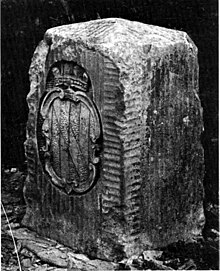
The line was established to end a boundary dispute between the British colonies of Maryland and Pennsylvania/Delaware. Maryland had been granted the territory north of the Potomac River up to the fortieth parallel. Pennsylvania's grant defined the colony's southern boundary as following a 12-mile (radius) circle (19 km) counter-clockwise from the Delaware River until it hit "the beginning of the fortieth degree of Northern latitude." From there the boundary was to follow the fortieth parallel due west for five degrees of longitude. But the fortieth parallel does not in fact intersect the 12-mile circle, instead lying significantly farther north. Thus Pennsylvania's southern boundary as defined in its charter was contradictory and unclear. The most serious problem was that the Maryland claim would put Philadelphia, the major city in Pennsylvania, within Maryland.[1]
The dispute was peacefully resolved in 1767[7] when the boundary was fixed as follows:
- Between Pennsylvania and Maryland:
- The parallel (latitude line) 15 miles (24 km) south of the then southernmost point in Philadelphia, measured to be at about 39°43′ N and agreed upon as the Maryland–Pennsylvania line.
- Between Delaware and Maryland:
- The existing east–west transpeninsular line from the Atlantic Ocean to the Chesapeake Bay, as far as its midpoint from the Atlantic.
- A 12-mile (radius) circle (12 mi (19 km)) around the city of New Castle, Delaware.
- A "tangent line" connecting the midpoint of the transpeninsular line to the western side of the 12-mile circle.
- A "north line" along the meridian (line of longitude) from the tangent point to the Maryland Pennsylvania border.
- Should any land within the 12-mile circle fall west of the north line, it would remain part of Delaware. (This was indeed the case, and this border is the "arc line".)

The disputants engaged an expert British team, astronomer Charles Mason and surveyor Jeremiah Dixon, to survey what became known as the Mason–Dixon line.[8][9] It cost the Calverts of Maryland and the Penns of Pennsylvania £3,512 9/- (9 shillings 0 pence) to have 244 miles (393 km) surveyed with such accuracy. To them the money was well spent, for in a new country there was no other way of establishing ownership.[10][11]
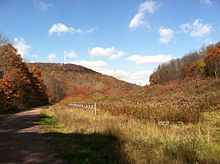
The Mason–Dixon line is made up of four segments corresponding to the terms of the settlement:
- the tangent line
- the north line
- the arc line
- the 39°43′ N parallel
The most difficult task was fixing the tangent line, as they had to confirm the accuracy of the transpeninsular line midpoint and the 12-mile circle, determine the tangent point along the circle, and then actually survey and monument the border. They then surveyed the north and arc lines. They did this work between 1763 and 1767. This actually left a small wedge of land in dispute between Delaware and Pennsylvania until 1921.[12][better source needed]
In April 1765, Mason and Dixon began their survey of the more famous Maryland–Pennsylvania line. They were commissioned to run it for a distance of five degrees of longitude west from the Delaware River, fixing the western boundary of Pennsylvania (see the entry for Yohogania County). However, in October 1767, at Dunkard Creek near Mount Morris, Pennsylvania, nearly 244 miles (393 km) west of the Delaware, their Iroquois guides refused to go any further, having reached the border of their lands with the Lenape, with whom they were engaged in hostilities. As such the group was forced to quit, and on October 11, they made their final observations, 233 miles (375 km) from their starting point.[13]
In 1784, surveyors David Rittenhouse and Andrew Ellicott and their crew completed the survey of the Mason–Dixon line to the southwest corner of Pennsylvania, five degrees from the Delaware River.[14] Other surveyors continued west to the Ohio River. The section of the line between the southwestern corner of Pennsylvania and the river is the county line between Marshall and Wetzel counties, West Virginia.[15]
The Mason–Dixon line has been resurveyed three times: in 1849, 1900, and in the 1960s.[8] On November 14, 1963, during the bicentennial of the Mason–Dixon line, U.S. President John F. Kennedy opened a newly completed section of Interstate 95 where it crossed the Maryland–Delaware border. It was one of his last public appearances before his assassination in Dallas, Texas. The Delaware Turnpike and the Maryland portion of the new road were later designated as the John F. Kennedy Memorial Highway.
Systematic errors and experiments to weigh the Earth
Mason and Dixon could only do the work as accurately as they did due to the work of Nevil Maskelyne, some of whose instruments they used.[16] There was keen interest in their work and much communication between the surveyors, Maskelyne and other members of the British Scientific establishment in the Royal Society in Britain, notably Henry Cavendish.[17][18][19] During such survey work, it is normal to survey from point to point along the line and then survey back to the starting point, where if there were no errors the origin and re-surveyed position would coincide.[20] Normally the return errors would be random – i.e. the return survey errors compared to the intermediate points back to the start point would be spatially randomly distributed around the start point.[21] Mason and Dixon found that there were larger than expected systematic errors, i.e. non-random errors, that led the return survey consistently being in one direction away from the starting point.[22] When this information got back to the Royal Society members, Henry Cavendish realised that this may have been due to the gravitational pull of the Allegheny Mountains deflecting the theodolite plumb-bobs and spirit levels.[17][23][24] Maskelyne then proposed measuring the gravitational force causing this deflection induced by the pull of a nearby mountain upon a plumb-bob in 1772 and sent Mason (who had returned to England) on a site survey through central England and Scotland to find a suitable location during the summer of 1773.[25][26][27] Mason selected Schiehallion at which to conduct what became known as the Schiehallion experiment, which was carried out primarily by Maskelyne and determined the density of the Scottish mountain.[16][26][27] Several years later Cavendish used a very sensitive torsion balance to carry out the Cavendish experiment and determine the average density of Earth.[24]
In culture
Name
Mason and Dixon likely never heard the phrase, "Mason–Dixon line". The official report on the survey, issued in 1768, did not even mention their names.[6] While the term was used occasionally in the decades following the survey, it came into popular use when the Missouri Compromise named "Mason and Dixon's line" as part of the boundary between slave territory and free territory.[28]
Symbolism
In popular usage to people from the Northern United States, the Mason–Dixon line symbolizes a cultural boundary between the North and the South (Dixie). However, for many people who identify as Southern, Maryland is not considered a Southern state,[29] leading to confusion over terminology (for more on Maryland's position as southern or northern, see the Region section of the article on Dixie). Originally "Mason and Dixon's Line" referred to the border between Pennsylvania and Maryland. After Pennsylvania abolished slavery, it served as a demarcation line for the legality of slavery. That demarcation did not extend beyond Pennsylvania because Delaware, then a slave state, extended north and east of the boundary. Also lying north and east of the boundary was New Jersey, where slavery was formally abolished in 1846, but former slaves continued to be "apprenticed" to their masters until the passage of the Thirteenth Amendment to the United States Constitution in 1865.
The Missouri Compromise line (Parallel 36°30′ north) had a much clearer geographic connection to slavery in the United States leading up to the Civil War.[30]
In popular culture
Popular culture contains a multitude of references to the Mason–Dixon line as a general geographic division, or character names evoking it, although a minority of those specifically relate to the line itself.
Film
- Mason "The Line" Dixon is a leading character in Rocky Balboa (2006),[31] the sixth film in the Rocky franchise, directed by and starring Sylvester Stallone. Played by real-life boxer Antonio Tarver, Dixon is the current World Heavyweight Boxing Champion who is ridiculed for having never fought a real contender, and who thus agrees to an exhibition fight against the nearly 60-year-old Rocky Balboa.[32]
- In Attack of the Killer Tomatoes, Mason Dixon is the leader of a government task force dedicated to stopping the worldwide crisis when tomatoes turn malignant.[33]
- In Three Billboards Outside Ebbing, Missouri the racist cop played by Sam Rockwell is named "Jason Dixon".
Cartoons
The line makes several appearances[34] in the 1953 Bugs Bunny cartoon "Southern Fried Rabbit". The line separates the drought affected North from which the "Yankee" Bugs leaves in search of carrots in the green lands of the "Dixie" south, the latter being guarded by Yosemite Sam.
Literature
- In the novel People's Choice by Jeff Greenfield, the character of W. Dixon Mason is an African-American preacher who plays a major role in determining the next U.S. President when the elected candidate dies between the popular election and the Electoral College formal vote.[35][better source needed]
- Mason & Dixon (1997) is the title of a novel by American author Thomas Pynchon.[36] The novel meanders widely through the lives of Mason and Dixon, traditional American history, and other themes such as hollow earth theory, geomancy, deism, and – perhaps – alien abduction.[37]
Music
- The 1918 song, "Rock-a-Bye Your Baby with a Dixie Melody", written by Jean Schwartz and popularized by Al Jolson, includes the lyric Just hang my cradle, Mammy mine/ Right on that Mason–Dixon Line.
- A small group of musicians from Paul Whiteman's orchestra led by C melody saxophonist Frank Trumbauer and including Bix Beiderbecke recorded two sides for Columbia on May 15, 1929 titled, "Alabammy Snow" and "What A Day!" under the pseudonym, "Mason–Dixon Orchestra".[38] It is probable that they chose this pseudonym because the catalog number of the record would be 1861-D, 1861 being the year that the American Civil War began.
- The lyric "First to cross the Mason–Dixon line" features in the opening verse of the song "I've done it again" (composers Marianne Faithfull / Barry Reynolds) on Grace Jones' 1981 album Nightclubbing. Nightclubbing (Grace Jones album)
- The Mason–Dixon line provides the main narrative for the song "Sailing to Philadelphia" (featuring James Taylor) by British singer-songwriter and guitarist Mark Knopfler.
- The 1955 song, "Hey, Porter", by Johnny Cash makes reference to the Mason–Dixon line in the line, How much longer will it be until we cross that Mason-Dixon line?
- The Shires 2015 song "State Lines" includes the lyrics "Like when you roll your eyes like a cool new Yorker, Driving across the Mason–Dixon line"
Sports
- In the regional baseball rivalry between the New York Yankees and the Boston Red Sox, the theoretical border that separates population centers that are majority-Red Sox fans from majority-Yankees fans in Connecticut is sometimes called the "Munson-Nixon Line"[39][40][41], in a reference to the Mason–Dixon line. Credited to Steve Rushin of Sports Illustrated[39], the line is named for famed Yankee catcher Thurman Munson and Red Sox right fielder Trot Nixon.
See also
- Collins–Valentine line, the boundary between the province of Quebec and the states of New York and Vermont
- Delaware Boundary Markers
- Penn–Calvert boundary dispute
- Mason and Dixon Survey Terminal Point
- Star Gazers' Stone
- Tofu Curtain
- Weißwurstäquator, a similar border line in Germany between the Northern and Southern areas of the country.
References
Notes
- ^ a b c d e Hubbard, Bill, Jr. (2009). American Boundaries: the Nation, the States, the Rectangular Survey. University of Chicago Press. pp. 20–29. ISBN 978-0-226-35591-7.
{{cite book}}: CS1 maint: multiple names: authors list (link) - ^ Barton, William (1818). Memoirs of the life of David Rittenhouse, LLD. F.R.S. E. Parker. pp. 282–283.
- ^ "Slavery in Delaware". Slavery in the North. Retrieved October 6, 2015.
- ^ Danson, Edwin (2001). Drawing the Line How Mason and Dixon Surveyed the Most Famous Border in America. John Wiley. p. 54.
- ^ Wilford, John Noble (2001). The Mapmakers: Revised Edition. Random House Digital, Inc. pp. 215–216. ISBN 978-0-375-70850-3. Retrieved November 1, 2012.
- ^ a b William Ecenbarger, "Neglecting the Mason–Dixon boundary stones", The Washington Post, January 1, 2017, p. C4.
- ^ Konkle, Burton Alva. (1932). Benjamin Chew 1722–1810: Head of the Pennsylvania judiciary system under colony and commonwealth. Philadelphia: University of Pennsylvania Press. p. 63-4.
- ^ a b "A Plan of the West Line or Parallel of Latitude". World Digital Library. 1768. Retrieved June 30, 2013.
- ^ "The men who drew the Mason–Dixon Line". BBC. September 2, 2017. Retrieved September 2, 2017.
- ^ Linklater, Andro (September 30, 2003). Measuring America. Penguin. p. 33. ISBN 978-0-452-28459-3.
- ^ Mason, A. Hughlett; Swindler, William F. (February 1964). "Mason & Dixon: their Line and its Legend". American Heritage. 15 (2). Retrieved November 8, 2008.
- ^ Coast And Geodetic Survey, U.S (1895). "Annual Report of the Director". U.S. Coast and Geodetic Survey: 195. Retrieved December 20, 2012.
- ^ Danson, Edwin (2001). Drawing the Line: How Mason and Dixon Surveyed the Most Famous Border in America. John Wiley and Sons. pp. 178–79. ISBN 9780471437048.
- ^ Four surveyors were appointed by each of the states: Virginia appointed Dr. James Madison, Robert Andrews, John Page, and Andrew Ellicott, Pennsylvania appointed Dr. John Ewing (provost of University of Penn.), John Lukens (surveyor general of Penn.), Thomas Hutchins, and David Rittenhouse. Andrews and Ellicott completed the west end of the line for Virginia, (Mathews, Catherine Van Courtlandt (1908). Andrew Ellicott, His Life and Letters. New York: The Grafton Press. pp. 17–19.) while Hutchins and Ewing did so for Pennsylvania. (Hicks, Fredrick (1904). "Biographical Sketch of Thomas Hutchins". In Hicks, Fredrick (ed.). A Topographical Description of Virginia, Pennsylvania, Maryland and North Carolina, reprinted from the original edition of 1778. Cleveland: The Burrow Brothers Company. p. 32.)
- ^ Strang, Cameron (2014). "Mason–Dixon Line| Encyclopedia of Greater Philadelphia". The Encyclopedia of Greater Philadelphia. Rutgers University. Retrieved November 2015.
{{cite web}}: Check date values in:|accessdate=(help) - ^ a b Davies, R.D (1985). "A Commemoration of Maskelyne at Schiehallion". Quarterly Journal of the Royal Astronomical Society. 26 (3): 289–294. Bibcode:1985QJRAS..26..289D.
- ^ a b Note the comments on Cavendish's speculation in the introductory notes, and the multiple correspondences with Maskelyne in: Mason, Charles; Dixon, Jeremiah. "The Journal of Charles Mason and Jeremiah Dixon 1763–1768" (pdf). Retrieved January 5, 2011.
- ^ Nevil Maskelyne was elected a Royal Society Fellow on April 27, 1758; see "List of Fellows of the Royal Society 1660–2007" (pdf). K–Z. Royal Society. 2007: 238. Retrieved January 5, 2011.
{{cite journal}}: Cite journal requires|journal=(help) - ^ Henry Cavendish was elected a Royal Society Fellow on May 1, 1760; see "List of Fellows of the Royal Society 1660–2007" (pdf). A–J. Royal Society. 2007: 66. Retrieved January 5, 2011.
{{cite journal}}: Cite journal requires|journal=(help) - ^ "Specifications and Recommendations for Control Surveys and Survey Markers". Natural Resources Canada. December 27, 2007. p. TABLE E-VI POSITION DIFFERENCES. Retrieved January 6, 2011.
Double run in straight line by helicopter between control spaced at 80 km.
- ^ Taylor, John Robert (1999). An Introduction to Error Analysis: The Study of Uncertainties in Physical Measurements. University Science Books. p. 94, §4.1. ISBN 0-935702-75-X. Retrieved January 5, 2011.
- ^ Mentzer, Robert. "How Mason and Dixon Ran Their Line" (pdf). Retrieved January 5, 2011.
- ^ Schaffer, Simon (May 20, 2010). "The Cavendish Family in Science". BBC Radio 4 (Interview).
{{cite interview}}: Unknown parameter|subjectlink=ignored (|subject-link=suggested) (help) - ^ a b Tretkoff, Ernie. "This Month in Physics History June 1798: Cavendish weighs the world". American Physical Society. Retrieved January 3, 2011.
- ^ Maskelyne, Nevil (January 1, 1775). "An account of observations made on the mountain Schehallien for finding its attraction". Philosophical Transactions of the Royal Society of London. 65. London: 500–542. doi:10.1098/rstl.1775.0050. Retrieved January 5, 2011.
Accordingly Mr. Charles Mason, who had been employed on several astronomical occasions by the Royal Society, was appointed to make a tour through the Highlands of Scotland in the summer of the year 1773, taking notice of the principal hills in England which lay in his route either in his going or in his return.
- ^ a b Sillitto, Richard M. (October 31, 1990). "Maskelyne on Schiehallion". The Royal Philosophical Society of Glasgow. Retrieved January 3, 2011.
The Royal Society agreed to a proposal that it despatch a surveyor, a Mr Charles Mason whom they had previously employed on astronomical projects, all the way to Scotland and back, to survey likely-looking mountains, and to select a suitable mountain – ideally it should be a steep-sided cone, or a wedge with its apex ridge running W – E and with steep faces to N and S, and separated from the nearest neighbours to N and S by low land. Mr Mason selected for them a mountain at "the centre of Scotland", Schiehallion – a wedge, with the summit ridge running nearly W – E, 3547 ft above sea level at its western summit, about 3000 ft at the E-end of the ridge; it presents steep faces to the trench to the N which contains Loch Rannoch and Loch Tummel, and to the deep Gleann Mor to the S. [An approximate altitude for Gleann Mor is 1500 feet, and for the land at the same distance to the north of the ridge is 1600 ft.]
- ^ a b Mackenzie, A. Stanley (1900). "Account of Maskelyne's experiments on Schehallien". The Laws of Gravitation: Memoirs by Newton, Bouguer and Cavendish; together with abstracts of other important memoirs. New York: American Book Company. p. 53. Retrieved January 3, 2011.
In 1772...The proposal was favourably received by the Society, and Mr. Charles Mason was sent to examine various hills in England and Scotland, and to select the most suitable (32). Mason found the two hills referred to by Maskelyne were not suitable; and fixed upon Schehallien in Perthshire as offering the best situation.
- ^ John Mackenzie, "A brief history of the Mason–Dixon Line", APEC/CANR, University of Delaware; accessed 2017.01.05.
- ^ Rasmussen, Frederick (March 28, 2010). "Are we Northern? Southern? Yes". The Baltimore Sun. Retrieved February 23, 2018.
- ^ "An Act to provide a temporary Government for the Territory of Colorado" (PDF). Thirty-sixth United States Congress. February 28, 1861. Retrieved February 22, 2007.
- ^ "Rocky Balboa". The Internet Movie Database. 2006.
- ^ "Film Review". Empire Magazine. 2007.
- ^ Dean, Sam. "Attack of the Killer Tomatoes: An Oral History of the 1978 Film".
- ^ "still from the cartoon "southern fried rabbit" showing the line". http://yosemite-sam.net/. 2017.
{{cite web}}: External link in|website= - ^ "Fiction Book Review: People's Choice by Jeff Greenfield, Author Putnam Publishing Group $22.95 (309p) ISBN 978-0-399-13812-6".
- ^ "Book review - Mason & Dixon". The New York Times. 1997.
- ^ "Mason & Dixon". ThomasPynchon.com.
- ^ Discography of American Historical Recordings, s.v. "Columbia 1861-D (10-in. double-faced)," accessed August 30, 2017, http://adp.library.ucsb.edu/index.php/object/detail/196765/Columbia_1861-D.
- ^ a b Giratikanon, Tom; Katz, Josh; Leonhardt, David; Quealy, Kevin (April 24, 2014). "Up Close on Baseball's Borders". The New York Times. ISSN 0362-4331. Retrieved October 25, 2017.
- ^ RUSHIN, STEVE. "Reconcilable Differences". SI.com. Retrieved October 25, 2017.
- ^ "Baseball's Borders". The American Spectator. April 25, 2014. Retrieved October 25, 2017.
Further reading
- Danson, Edwin. Drawing the Line: How Mason and Dixon Surveyed the Most Famous Border in America. Wiley. ISBN 0-471-38502-6
- Ecenbarger, Bill. Walkin' the Line: A Journey from Past to Present Along the Mason–Dixon. M. Evans. ISBN 978-0-87131-962-3
External links
- The Mason and Dixon Line Preservation Partnership Collection of historical articles and pictures
- The Evolution of the Mason and Dixon Line Facsimile copy of this 1902 text available on-line at Penn State's Digital Bookshelf
- . New International Encyclopedia. 1905.
- . Encyclopædia Britannica (11th ed.). 1911.
- . . 1914.
- Mason and Dixon in Mill Creek, Friends of White Clay Creek State Park
- University of North Carolina: Southern Things
- [1] The Historical Society of Pennsylvania (1855)
- 1767 establishments in the Thirteen Colonies
- 1767 in international relations
- Mason–Dixon line
- Cultural boundaries
- Borders of Delaware
- Borders of Maryland
- Borders of Pennsylvania
- Borders of West Virginia
- Delaware in the American Civil War
- Geographic history of the United States
- Historic Civil Engineering Landmarks
- History of the Southern United States
- History of United States expansionism
- Land surveying of the United States
- Lines of latitude
- Maryland in the American Civil War
- Pennsylvania in the American Civil War
- Pre-statehood history of Maryland
- Pre-statehood history of Pennsylvania
- Pre-statehood history of Virginia
- Pre-statehood history of West Virginia
- Slavery in the United States
- Borders of U.S. states
- Lines of longitude
